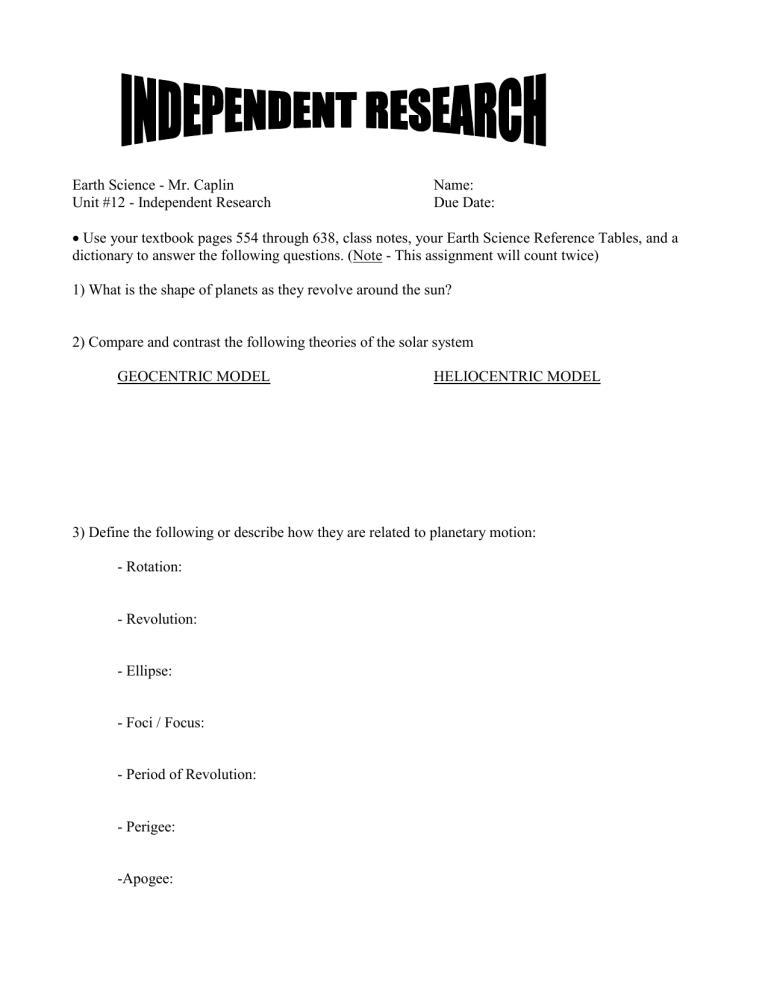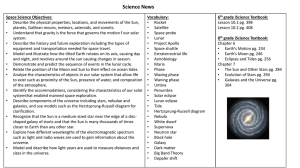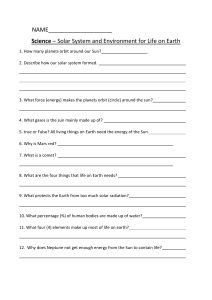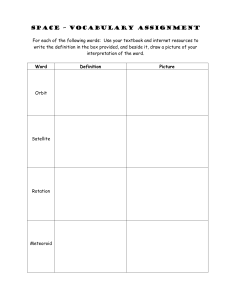
Earth Science - Mr. Caplin Unit #12 - Independent Research Name: Due Date: Use your textbook pages 554 through 638, class notes, your Earth Science Reference Tables, and a dictionary to answer the following questions. (Note - This assignment will count twice) 1) What is the shape of planets as they revolve around the sun? 2) Compare and contrast the following theories of the solar system GEOCENTRIC MODEL HELIOCENTRIC MODEL 3) Define the following or describe how they are related to planetary motion: - Rotation: - Revolution: - Ellipse: - Foci / Focus: - Period of Revolution: - Perigee: -Apogee: 4) Name and describe the two forces that keep planets in motion around the sun. a) b) 5) List and Explain Kepler's Three Laws of Planetary Motion - 1st Law: - 2nd Law: - 3rd Law: 6) Compare and contrast the following TERESTRIAL PLANETS JOVIAN PLANETS 7) Identify the planet that matches the following statement. - Most Elliptical Orbit: - Largest Jovian Planets: - Largest Terrestrial Planet: - Greatest Number of Moons: - Warmest Surface: - Longest Day 8) What is the difference between a meteor and a meteorite? 9) How are meteors different from comets? 10) How far is the sun from earth? 11) What process allows the sun create heat and light? 12) What are sunspots and how are they created? 13) Define the following: - Solar Eclipse: - Lunar Eclipse: - Partial Eclipse: - Umbra: - Penumbra: 14) Draw and label a lunar eclipse. 15) Draw and label solar eclipse. 16) Which occurs more often, solar or lunar eclipse? 17) How long do eclipses last? 18) Draw and label the eight phases of the moon. #1 #2 #3 #4 #5 #6 #7 #8 19) How long does it take for the moon to make one complete revolution around the earth? 20) Define the following: - Nebula: - Constellation: - Zenith: - Apparent Magnitude: - Absolute Magnitude: - Supernova: - Galaxy: 21) Why do stars appear to have different colors? 22) What does the H-R Diagram represent? 23) Describe the following types of stars based upon the variable in the H-R Diagram? a) Main Sequence Stars: b) Red Dwarfs: c) White Dwarfs: d) Red Giants: e) Supergiants: 24) Where does our sun fit into the H-R diagram? 25) What is a black hole? 26) How does a black hole form? 27) Names three types of galaxies: a) b) c) 28) Which galaxy do we live in? 29) How old is the solar system? 30) How old is the universe? 31) Describe the Big Bang Theory. 32) Describe the theory of the expanding universe. 33) What evidence exists that the universe is expanding? In your answer explain the ideas of red shift / blue shift. 34) Provide an analogy for the Doppler Effect. 35) Label the following in order of their size, 1 being the largest and 4 being the smallest. - Solar System: - Planets: - Universe: - Galaxy: 36) Draw a diagram representing a person viewing Polaris at the given latitudes. EQUATOR CANANDAIGUA NORTH POLE 37) What is circumpolar motion and how does it prove that the earth rotates on its axis? 38) What is retrograde motion?




